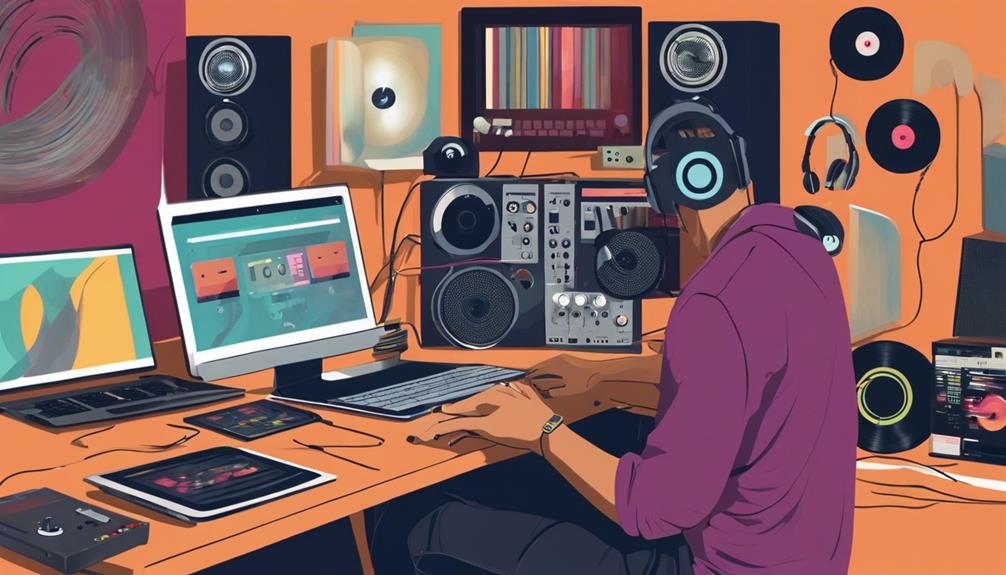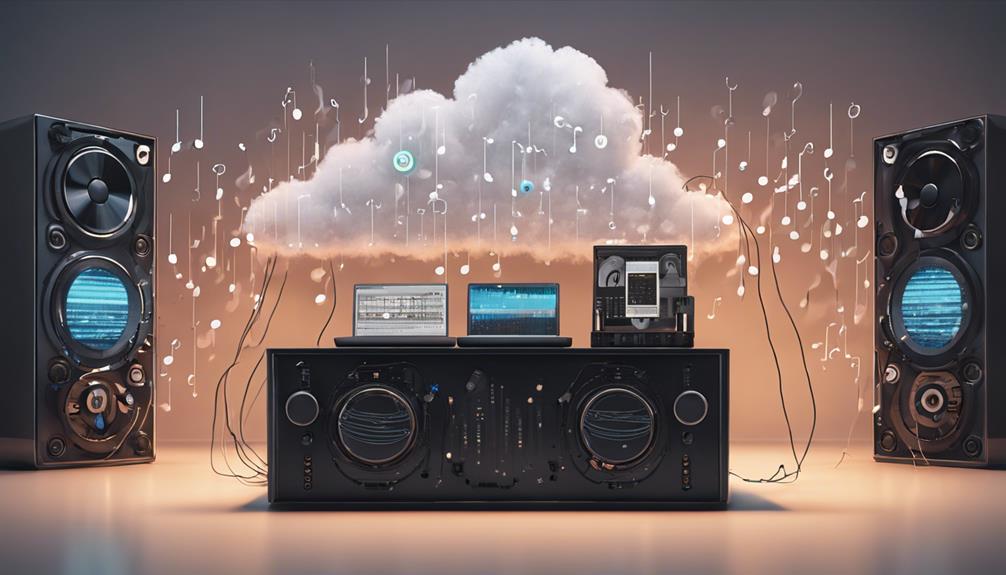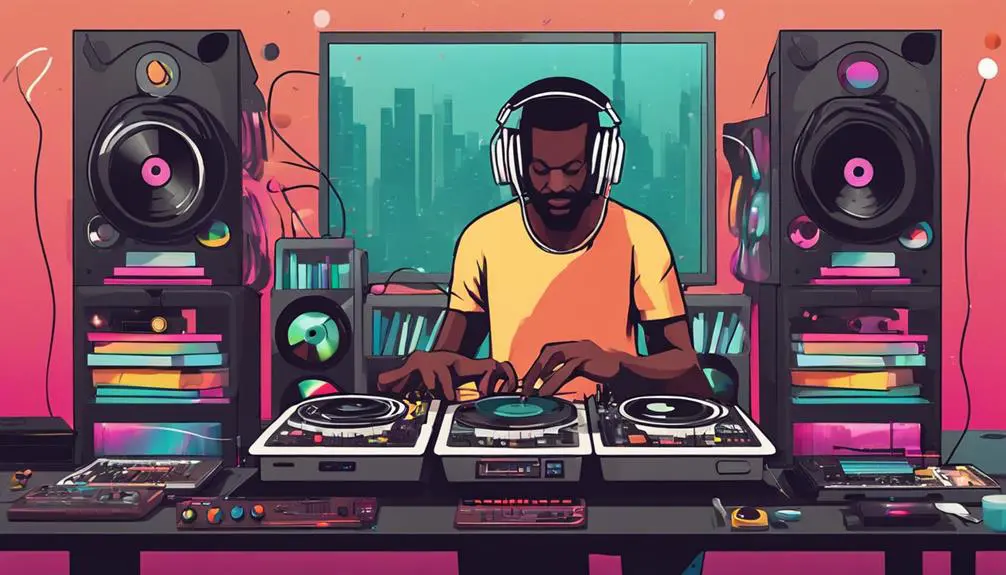Subtotal: £99.00
Start by categorizing your tracks monthly by genre, mood, or energy. Consistently tag each song to find them easier during your sets. Make sure your playlists are gig-specific, tailoring them to the venue and audience’s vibes. Regularly update and maintain your music library from sources like Beatport to avoid duplicates and outdated info. Set aside time for sorting and managing digital storage to speed up access during performances. Use smart playlists in DJ software to automate and refine your selections. To conclude, always back up your library, including all metadata. Following these tips will definitely enhance your future gigs.
Key Takeaways
- Categorize and tag tracks by genre, mood, or energy to simplify search and selection.
- Regularly update and maintain metadata to ensure playlist accuracy.
- Create gig-specific playlists tailored to the audience and venue needs.
- Use smart playlists to automate updates and streamline workflow.
- Back up the music library regularly, including all metadata and cue points.
Categorizing New Tracks Monthly
To streamline your DJ set preparations, you should categorize new tracks monthly by genre, mood, or energy level, guaranteeing each playlist is meticulously updated and readily accessible. This genre-based categorization lets you quickly find the right track to match the vibe you’re aiming for, whether it’s a chill lounge set or a high-energy electronic dance music bash.
Consider setting aside specific times each month dedicated to updating your playlists. This routine guarantees you aren’t scrambling before a gig. You’ll integrate new tracks into your existing collections using a consistent tagging system. Labels like ‘Deep House – High Energy’ or ‘Indie Pop – Mellow’ clarify what each file contains without needing to listen to each track again.
Moreover, mood-based playlists can dramatically enhance your performance by allowing you to shift the atmosphere seamlessly. By having these emotional cues pre-sorted, you can respond to the crowd’s energy in real-time, making your sets more dynamic and engaging.
Weekly Track Information Updates
As you manage your digital music collection, understanding the sources from which you update your tracks each week is vital. These updates not only refine your library’s metadata but also greatly influence your set lists, ensuring they’re dynamic and well-curated.
Update Sources Overview
Weekly updates of your digital music sources, such as Beatport, Traxsource, and Bandcamp, are crucial for maintaining a fresh and accurate DJ library. You’ll want to stay ahead by making sure these platforms are regularly refreshed with the latest tracks and accurate data.
- Beatport vs. Traxsource: Compare both for exclusive releases and genre-specific tracks.
- Bandcamp releases: Often includes unique and independent artist content.
- Edit metadata: Guarantee artist names, track titles, and genres are up-to-date.
- Organize playlists: Sort new additions into genre-specific or mood-based playlists.
- Avoid duplicates: Regular checks help prevent the same track from cluttering your collection.
Impact on Set Lists
Keeping current track information each week guarantees you can swiftly find and sequence songs for impactful, dynamic sets. This practice is essential for improving connections and enhancing flow. Weekly updates mean you’re always prepared with the freshest tracks and best playlist accuracy.
| Benefit | Description |
|---|---|
| Enhanced Searchability | Quickly locate tracks with updated metadata. |
| Improved Playlist Accuracy | Minimize errors by keeping track details fresh. |
| Seamless Connections | Smoothly mix tracks with accurate BPM and key. |
Gig-Specific Playlist Setup
To guarantee your music resonates with the specific audience and atmosphere of each event, create tailored playlists for every gig you DJ. By focusing on theme customization and audience engagement, you make sure that each track aligns with the event’s vibe and people’s preferences. This approach not only enhances event dynamics but also showcases your adaptability and music diversity.
Here’s how to set up your gig-specific playlists effectively:
- Assess the Event’s Theme and Audience: Start by understanding the theme and the demographics of the audience. This ensures your music selection hits the right note.
- Vary Genres and Energy Levels: Include a mix of genres and different energy tracks to cater to various moments and moods throughout the event.
- Organize Tracks by Set Time: Sequence your music from opening to peak to closing to maintain an energy progression that matches the event’s flow.
- Consider the Venue and Event Type: Tailor your playlist to the size of the venue and the specific type of event, whether it’s a corporate gala, a wedding, or a club night.
- Regular Updates: Keep your playlists fresh and relevant by regularly updating them based on current musical trends and past audience feedback.
Balancing Music Organization Time
To effectively manage your digital music collection, it’s important to set regular sorting sessions. You’ll need to prioritize your essential tracks, especially when preparing for upcoming gigs to make sure your set lists are both dynamic and well-suited to the event.
Additionally, leveraging smart playlists can greatly enhance your efficiency by automating part of the organizational process.
Set Regular Sorting Sessions
Scheduling regular sorting sessions each week allows you to efficiently manage your digital music library. This ensures that essential tasks such as updating metadata, creating playlists, and backing up files are prioritized.
Here’s how you can make the most of these sessions:
- Time Management: Allocate a specific time each week dedicated solely to sorting your digital music.
- Organization Tips: Break down tasks into manageable chunks to avoid feeling overwhelmed.
- Digital Storage: Regularly check and optimize your storage solutions to guarantee they meet your needs.
- Music File Formats: Update and convert files as needed to maintain compatibility and quality.
- Prevent Clutter: Consistently clear out unnecessary files, maintaining a streamlined library for quick access.
These steps will help you maintain an organized, accessible digital music collection.
Prioritize Essential Tracks
After setting aside time each week for sorting your digital music, it’s important to focus on organizing tracks that are pivotal for your upcoming performances or resonate deeply with your unique DJ style. Prioritize essential tracks by identifying those that define your DJ persona or are consistent crowd-pleasers.
This targeted track selection not only streamlines your music library but also greatly enhances your performance by ensuring you have quick access to high-impact tracks that lift your sets. Allocate time to categorize these must-have tracks in a way that aligns with your current musical direction or event themes, ensuring every session you perform is both relevant and cohesive.
This strategic approach optimizes your preparation time and keeps your performances sharp.
Utilize Smart Playlists
Utilizing smart playlists can greatly streamline your music organization by automatically updating selections based on your predefined criteria such as BPM, genre, or mood. Here’s how you can maximize smart playlist benefits with effective customization options:
- Automate Updates: Add new tracks or update metadata, and your smart playlists refresh automatically.
- Dynamic Criteria: Set conditions like key, play count, or genre for tailored playlist creation.
- Genre-specific Lists: Effortlessly compile tracks into electronic, hip hop, or jazz playlists.
- Mood-based Selections: Create playlists that match various moods or event atmospheres.
- Workflow Enhancement: Use smart playlists in DJ software such as Serato or Rekordbox to improve your performance efficiency.
These time-saving features make sure you’re always ready to perform without constant manual updates.
Regular Music Library Backups
To safeguard your entire music collection, it’s important to back up your library every six weeks, including all cue points and metadata. This disciplined approach not only protects your music but also guarantees that every essential piece of information, from track settings to loop points, is securely stored. Consider setting up automated backup reminders to maintain this schedule without fail. It’s easy to overlook a backup session amidst your busy schedule, but these reminders can be a real lifesaver.
Diversifying your backup solutions is also vital. Cloud storage options provide an accessible and secure platform to store your music files offsite, protecting them against physical damage to your equipment. On the other hand, external hard drives offer a reliable and quick method for local backups. They’re particularly useful for large music libraries that require substantial storage space.
Implement data recovery strategies before you face a crisis. Regular backups reduce the risk of catastrophic data loss, but knowing how to recover lost files efficiently can minimize downtime in your DJing schedule. Explore tutorials and resources that guide you through the nuances of music library backups and data recovery. This knowledge will empower you to handle unexpected situations confidently, ensuring your music library remains intact and readily available for your next gig.
Utilizing DJ Software Tools
As a DJ, you’ll find that software tools like Rekordbox, Serato, and Traktor are invaluable for efficiently organizing your digital music library. These powerful platforms offer a suite of features that enhance your ability to manage and perform your music with precision.
Here’s how you can leverage these tools to streamline your music organization:
- Metadata management: Update and maintain track details like artist, title, album, and label to make sure your library is easily searchable. This allows you to find tracks swiftly during a live session.
- Cue point creation: Set up cue points in advance to mark specific parts of a track for quick access during performances. This preparation saves you time and enhances your live mixing capabilities.
- Beat grid alignment: Use the beat grid feature to align tracks perfectly, ensuring smooth progressions between songs. This is essential for maintaining the flow and energy of your set.
- Keyboard shortcuts: Learn and utilize keyboard shortcuts within your DJ software to speed up the process of organizing tracks and exploring your library.
- Catalog updates: Regularly catalog old tunes in small batches. This keeps your collection current and manageable, preventing overwhelming backlogs.
These strategies not only improve your efficiency but also enhance your performance by making sure you’re always prepared with a well-organized music library.
Advanced Playlist Techniques
Smart playlists can revolutionize how you manage your digital music collection, automatically updating to reflect changes in criteria such as BPM range or genre. By leveraging smart filtering, you’ll guarantee your playlists always match your current needs, whether prepping for a chill lounge set or a high-energy club night.
Consider creating nested playlists within these smart playlists. This method allows you to refine your music organization even further, grouping tracks not only by genre but also by sub-genres or specific vibes, enhancing your ability to quickly access the perfect track.
Customized tagging within these playlists is essential. By tagging tracks with unique identifiers like ‘crowd-favorite’ or ‘late-night’, you can swiftly find the right music to fit the mood without manually searching through thousands of tracks.
Here’s a quick guide to setting up your playlists effectively:
| Feature | Benefit |
|---|---|
| Dynamic Rules | Keeps playlists fresh and relevant |
| Nested Playlists | Enhances categorization and access |
| Customized Tagging | Streamlines track selection |
| Smart Filtering | Quickly finds tracks by key or energy level |
Frequently Asked Questions
How to Organize Music Files for a Dj?
To organize your music files, start by using mp3Tag for file tagging. Then, curate playlists by themes, incorporating elements like BPM and key. This structured approach helps you quickly find the right track.
How Do You Organize Digital Music?
To organize digital music, start by genre tagging each track. Create playlists with specific themes, ensuring each is carefully curated for coherence. Regularly update and refine these to maintain a structured, accessible music library.
What Is the Best Music Library Manager for Djs?
The best music library manager for DJs depends on your needs. Consider software features and user reviews of Serato DJ Pro, Rekordbox, Traktor Pro, Virtual DJ, and Engine Prime for informed choices.
How to Structure a DJ Library?
To structure your DJ library, start by categorizing playlists by genre and mood. Utilize genre tagging and BPM sorting to enhance track retrieval. Maintain a curated, structured system for efficient set preparation.
Conclusion
Now that you’ve got the scoop on organizing your digital music, take action. Start by categorizing new tracks monthly and updating track information weekly.
Set up gig-specific playlists to streamline your performances. Remember, balancing your time is essential; don’t get bogged down.
Regularly back up your library to safeguard your collection. Harness your DJ software’s full potential and master advanced playlist techniques to keep your sets fresh.
Stay organized, stay creative, and let your music spin effortlessly.





